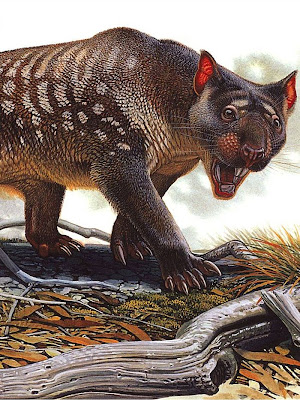Fierce debate: many of the 90 species of giant animals that roamed ancient Australia and New Guinea were wiped out before the arrival of Aboriginal people, say researchers. (Source: Peter Schouten/UNSW)
Stephen Pincock
There is no evidence to support the idea that humans
were primarily responsible for wiping out the extraordinary gigantic
animals that once roamed Australia, says a group of Australian and US
scientists.The claim is the latest salvo in a longstanding and ferocious scientific disagreement over what killed animals such as 100 kilogram marsupial lions, rhinoceros-sized marsupial Diprotodons and goannas as big as large saltwater crocodiles.
On one side of the debate, including the authors of the latest paper, are researchers who suggest megafauna gradually died out as climate change altered the landscape of Sahul, the single Pleistocene-era landmass that combined Australia and New Guinea.
On the other side, are those who argue that humans hunted the animals out of existence, who point to evidence suggesting the megafauna extinction occurred within 10,000 years of people arriving in Australia for the first time.
The latest paper, published in the Proceedings of the National Academy of Sciences , reviews published evidence on the topic and argues that the finger of blame points more definitively toward climate change.
The paper's authors say there is only firm evidence for about 8 to 14 megafauna species still existing when Aboriginal people arrived. Another 50 species were completely absent from the fossil record of the past 130,000 years.
On the other hand, they say, as more fine-grained environmental data has been gathered, it has become apparent that the climate of Sahul was increasingly arid and erratic climate during the past 450,000 years.
"There is very strong evidence that climate had a major role in the extinction process, and we have no evidence that humans had a major impact," says study author Judith Field, an archaeologist from the University of NSW.
"You have difficulty making the argument that humans had a major role in the extinction of the megafauna in Australia unless you can put humans and megafauna in the same place at the same time.
"Only one site on continental Australia does that," Field says referring to Cuddie Springs in south eastern Australia.
"What you can say is that there is now strong evidence pointing to climate as being the major driver."
Lead author, Associate Professor Stephen Wroe, also from the University of NSW, says the interpretation that humans drove the extinction rests on assumptions that have increasingly been shown to be incorrect.
"There has never been any direct evidence of humans preying on extinct megafauna in Sahul, or even of a tool-kit that was appropriate for big-game hunting," Wroe says.
"It is now increasingly clear that the disappearance of the megafauna of Sahul took place over tens, if not hundreds, of millennia under the influence of inexorable, albeit erratic, climatic deterioration," he says.
Scientific disagreement
But Christopher Johnson, professor of wildlife conservation from the University of Tasmania argues that the new paper adds little to the debate."It contains no new evidence. It is a commentary paper, and what it mainly does is re-state an interpretation of megafaunal extinction in Australia that these same authors have presented in many previous similar publications."
Johnson, together with climate change scientist Professor Barry Brook from the University of Adelaide, dispute the authors' interpretation of the evidence on climate change.
Johnson also says they misinterpret the fossil evidence of the extinction of the megafauna.
"It is well known that even when a whole group of species goes extinct simultaneously, the fossil record will give the appearance of a staggered series of extinctions because fossils don't actually date the extinction of species, and the latest fossil for a species will often have been formed long before the species actually went extinct," he says.
"This is a well-known problem in interpretation of the fossil record, and there are well established methods available to deal with it."
Responding to this criticism, Field says the most recent fossil evidence for some megafauna species dates from more than 100,000 years before humans arrived on Sahul.
"We actually discuss this in the paper.
"The question you must ask is how many thousands of years do you allow after the last appearance date of a species before accepting an animal is now extinct?"


0 comments:
Post a Comment